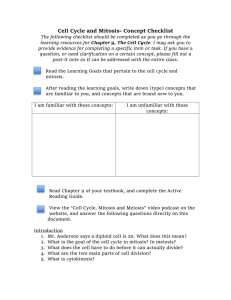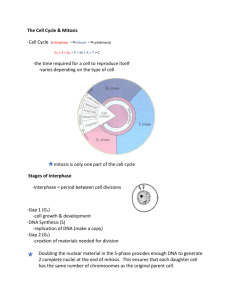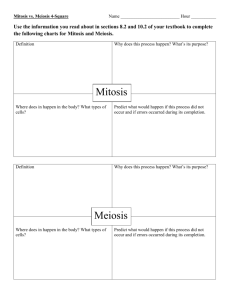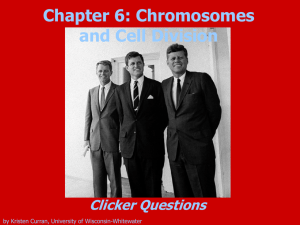Unit 6 Agenda—Cell Division
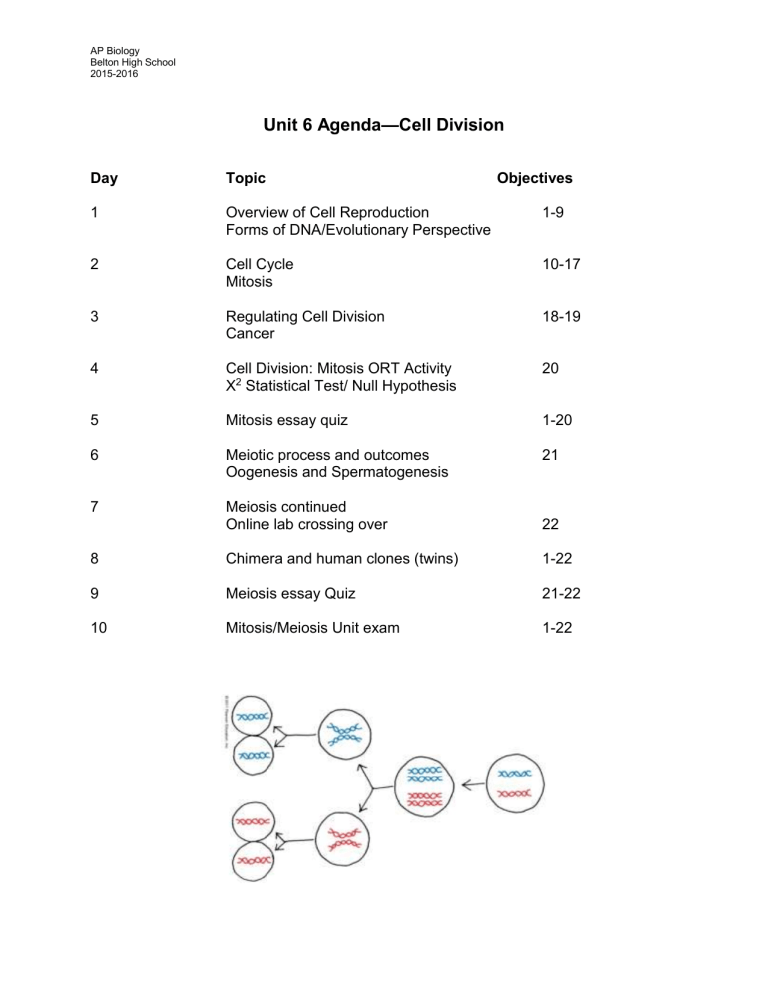
AP Biology
Belton High School
2015-2016
Day
1
2
3
4
5
6
7
8
9
10
Unit 6 Agenda —Cell Division
Topic
Overview of Cell Reproduction
Forms of DNA/Evolutionary Perspective
Objectives
1-9
Cell Cycle
Mitosis
10-17
18-19 Regulating Cell Division
Cancer
Cell Division: Mitosis ORT Activity
X 2 Statistical Test/ Null Hypothesis
Mitosis essay quiz
Meiotic process and outcomes
Oogenesis and Spermatogenesis
Meiosis continued
Online lab crossing over
Chimera and human clones (twins)
Meiosis essay Quiz
Mitosis/Meiosis Unit exam
20
1-20
21
22
1-22
21-22
1-22
AP Biology
Belton High School
2015-2016
Unit Objectives: Cell Division
1. Describe how an RNA containing proto-cell may have been the first reproductive unit on the planet.
2. Explain evidence which supports that prokaryotic cells evolved more than 3 billion years ago.
3. Explain the process of binary fission and compare it to mitotic cellular division
4. Formulate a connection between the speed of Binary fission and the population growth typical of prokaryotic life forms.
5. Distinguish between sexual and asexual reproduction, describe advantages of each and relate them to mitosis and/or meiosis as appropriate.
6. Indicate cell types in which mitosis and meiosis would occur in a given organism.
7. Compare the end products of mitosis and meiosis (include typical number of cells
AND chromosomal content of each cell).
8. Compare the chromosomal content of haploid and diploid cells and describe how to identify a picture of a cell as haploid or diploid.
9. Distinguish among chromosomes, sister chromatids and homologous chromosomes.
10. List the stages of the cell cycle and describe the major activities of these stages
(be sure to discuss all 3 portions of interphase).
11. Describe the roles of mitosis in the transmission of DNA in the life cycles of both unicellular and multicellular organisms.
12. Compare the cell cycle of an actively dividing cell with one that is specialized and no longer dividing.
13. Explain why mitosis should occur AFTER DNA replication is complete.
14. Describe the major EVENTS of mitosis proper and be able to recognize a diagram or micrograph of major stages (prophase, metaphase, anaphase and telophase).
15. Describe the spindle apparatus at metaphase including the roles and locations of: microtubules, kinetochores, centromere, and sister chromatids.
16. Compare cytokinesis in animals and plants and explain why there is a difference.
17. Describe how the stimulation or inhibition of the rate of cell division could be determined in a controlled experiment.
18. Explain how checkpoints are involved in cell cycle regulation and describe the roles of cyclin and cyclin-dependent kinases (cdk) in the G
2
checkpoint.
19. Explain how cancerous cell division is different from normal cell division (include checkpoints in your discussion).
20. Describe the significance of each of the following events of meiosis in ensuring proper gamete formation and genetic diversity in sexually reproducing organisms: the pairing of homologous chromosomes; the random orientation of homologous chromosome pairs; the separation of homologous chromosome pairs followed by the separation of sister chromatids; crossing over.
21. Define fertilization and describe its role in the transmission of DNA during sexual reproduction.
22. Explain the relationship between the frequency of crossing over and the location of genes on a chromosome.


